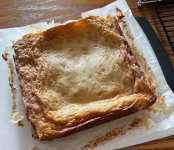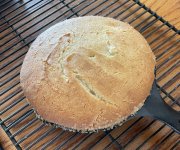After discussing this issue with my sister, I opted to try TWO versions of the generically named "butter cake" that they enjoyed in Arizona restaurants. Version One was from Paul Martin's restaurant in Scottsdale--thoughtfully describing "butter cake" on their menu as "the Original St. Louis Butter Cake."
Now see...how hard was THAT! Data, people, data! How can I duplicate a recipe if I have no idea where I'm starting at?
The NYTimes provided a recipe for--supposedly--an authentic St. Louis recipe with over 1,200 reviews and a 5-star rating. I figured that was a safe bet to be getting on with.
This...this was a weird cake. It has a yeasted risen base, topped with a batter made from almost the exact same ingredients. Base had yeast; topping had corn syrup. Other than that, the top and bottom were the same.
The result was a dry sweet bread base with a gooey buttery topping.
Ya, I'm not getting it either. The majority of St. Louis fans said they eat it for breakfast, so I guess you could stretch your imagination and think of it as a custard danish. I mainly thought of it as a lot of buttery sugar.
One of the NYT reviewers suggested lining the pan with parchment, so that's what I did.

Personally, I think I used too much yeasted dough as the base. It rose up around the pan edges and pooled the liquid topping to the center, so each slice didn't have distinct layers. It did pass muster with my sister and BIL, who agreed it tasted just like the Paul Martin version...only theirs was made in cast-iron skillets as a 2-person serving. There it is used as a vehicle for fruit topping, such as peaches or strawberries.
Version 2 was found online as a clone for "Mastro's Signature Warm Butter Cake." Maestro's menu provides a photo--an inverted ramekin topped with fruit and ice cream. This was the same plating that Paul Martin's used so I thought of it as a culinary substitute for strawberry shortcake.
This was simply a batter cake baked in cast-iron skillets coated with--wait for it--Butter-flavored Crisco--and turbinado sugar. Ya...absolutely NO BUTTER in this "butter cake." The recipe uses lots and lots of Crisco. One HUGE flaw I found with this recipe was she fills 6 ramekins...basic 3" ramekins. I filled 2 6" cast-iron skillets and still had enough batters for an entire 9" cake. WAY TOO MUCH BATTER!!

It ends up as a very neutral-tasting cake...sort of fluffy and a bit dry. I could see it working if it were coated with lots of moist fruit. Again, this version matched my sister's memory of the Maestro cake. They hadn't realized until now how different the cakes were. That's what happens when NOT ENOUGH DESCRIPTIVE ADJECTIVES ARE USED!
Okay, that's it for now. The recipes for both are in my original post
 recipeswap.org
recipeswap.org
By the way, NYTimes St. Louis butter cake fans were adamant that versions using cake mixes and cream cheese were an abomination that would not be tolerated by true lovers of this pastry.
Now see...how hard was THAT! Data, people, data! How can I duplicate a recipe if I have no idea where I'm starting at?
The NYTimes provided a recipe for--supposedly--an authentic St. Louis recipe with over 1,200 reviews and a 5-star rating. I figured that was a safe bet to be getting on with.
This...this was a weird cake. It has a yeasted risen base, topped with a batter made from almost the exact same ingredients. Base had yeast; topping had corn syrup. Other than that, the top and bottom were the same.
The result was a dry sweet bread base with a gooey buttery topping.
Ya, I'm not getting it either. The majority of St. Louis fans said they eat it for breakfast, so I guess you could stretch your imagination and think of it as a custard danish. I mainly thought of it as a lot of buttery sugar.
One of the NYT reviewers suggested lining the pan with parchment, so that's what I did.

Personally, I think I used too much yeasted dough as the base. It rose up around the pan edges and pooled the liquid topping to the center, so each slice didn't have distinct layers. It did pass muster with my sister and BIL, who agreed it tasted just like the Paul Martin version...only theirs was made in cast-iron skillets as a 2-person serving. There it is used as a vehicle for fruit topping, such as peaches or strawberries.
Version 2 was found online as a clone for "Mastro's Signature Warm Butter Cake." Maestro's menu provides a photo--an inverted ramekin topped with fruit and ice cream. This was the same plating that Paul Martin's used so I thought of it as a culinary substitute for strawberry shortcake.
This was simply a batter cake baked in cast-iron skillets coated with--wait for it--Butter-flavored Crisco--and turbinado sugar. Ya...absolutely NO BUTTER in this "butter cake." The recipe uses lots and lots of Crisco. One HUGE flaw I found with this recipe was she fills 6 ramekins...basic 3" ramekins. I filled 2 6" cast-iron skillets and still had enough batters for an entire 9" cake. WAY TOO MUCH BATTER!!

It ends up as a very neutral-tasting cake...sort of fluffy and a bit dry. I could see it working if it were coated with lots of moist fruit. Again, this version matched my sister's memory of the Maestro cake. They hadn't realized until now how different the cakes were. That's what happens when NOT ENOUGH DESCRIPTIVE ADJECTIVES ARE USED!
Okay, that's it for now. The recipes for both are in my original post
Questions for our Arizona friends: my sister now lives there and LOVES "butter cake"
I have no more information than that...other than it has a crispy edge and soft interior. They're currently near Phoenix and I've pinged her to get a location where she ate it. But she was pretty darned impressed. Thanks. M (I found a copycat version for a restaurant called Mastro (in...
By the way, NYTimes St. Louis butter cake fans were adamant that versions using cake mixes and cream cheese were an abomination that would not be tolerated by true lovers of this pastry.
Last edited:
